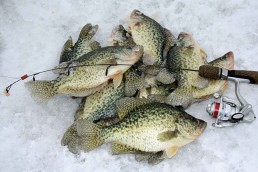Ice Fishing for Big Panfish
SHARE THIS POST
Big panfish are line-shy. That’s how they become big panfish.
I laid out my clothes. Drug out heavy boots with felt inserts. Got out my insulated underwear, flannel lined jeans and a wool shirt. Checked the buttons on my sheep liner overcoat and found my winter cap with earflaps and wool mittens. Ice fishing is no fun if you are just standing and shivering.
I organized my equipment, starting with my soft-tip, 36-inch ice fishing rod. I use 3-pound test mono line. (Big panfish are line-shy. That’s how they become big panfish!) My line is marked every two feet with an indelible marker. That way, I know what depth I’m fishing. If the fish are biting at the 6-foot mark, I can, by watching my marks, keep my bait at that depth. I hardly ever use a bobber. A soft rod tip will jerk with just a nibble. If the wind is blowing, your line will have a slight bow. When the line straightens out, you got a bite. Simple.
My go-to lures are Ratfinkee and the Half-Ant tungsten jig. The Ratfinkee comes with a fine-wire hook and a soft, tubular body. It can be made more attractive when tipped with a meal worm or a minnow. Remember, big bluegills prefer minnows. Use hook sizes 12 and 14. An open bluegill’s mouth is about the size of a dime.
I like the Half-Ant tungsten jig because it hangs vertically in the water, and upon occasion can be deadly for ‘gills and crappies. I’ve had good luck tipping the lure with live bait or plastics. Sometimes, one color works best; sometimes another. Depends on the fish, I guess.
After I got all my equipment together for the next day’s expedition, I had a wild hunch. I went to my computer and typed in IDNR. I scrolled down to the topographical map of Lake Miami. The map is a good one, showing all the sunken brush piles besides water depths. I printed one off and put it in my coat pocket, put my gear by the front door and scooted off the bed.
The next morning, my friend Buck and I headed out to Lake Miami. When we arrived, we met up with two of our buddies who were already out on the ice—Val Mannens and Dave Everhart.
It seems our Des Moines buddies were not getting along too well. Dave had somehow forgotten the fish locator and they were drilling and hoping. I pulled out the lake contour map and we studied it. Sunken brush piles were all over the west bank. I figured the best place to try was in the deeper water off a point that held two brush piles.
Are you enjoying this post?
You can be among the first to get the latest info on where to go, what to use and how to use it!
We were a hopeful bunch as we shuffled across the lake. The winter sun shone warm on our faces. A soft breeze from the north cheered us.
We stopped short of the west bank and matched our map with the actual point. Val drilled four holes about 6 feet apart. We all tied on Johnson Silver spoons and jigged them, trying to attract crappies. Buck caught a nice channel cat right off the bat! Dave had a fish on and lost it. We figured to give this spot a try.
I tied on a Half-ant and tipped it with a 1-inch Ice Stinger. I never use live bait anymore. Plastics are more durable and easier to put on a hook. They save time. Remember, you are not fishing unless your hook is in the water. I lowered my bait to the 5-foot mark on my line and gave it a twitch.
Buck tied on a 1/8-ounce jig and tipped it with a sliver of white pork rind. Val and Dave fished with slip bobbers and live minnows hooked below the dorsal fin. Buck caught two nice crappies—just bam! Bam! He started to brag, and then Dave and Val were getting bit.
The bite was slow but steady for the next half-hour. Buck caught another catfish, Dave caught and released a decent-sized bass, while either Val or I had fresh-caught crappies flopping on the ice. Then the bite stopped as if someone had flipped a switch.
We started reeling in equipment and throwing fish into buckets. and waited to talk to him. Andy Weubaer, the resident warden came by and checked our fishing licenses. He told us the fish would start biting again around two o’clock, so we headed to Val and Dave’s cabin for some stew and coffee to wait for the next bite!
Get better results from the time you spend fishing. Use information from the pros found in every issue of MidWest Outdoors, available by subscribing on our website.
MWO
SHARE THIS POST
You may also like...
Nothing found.
Did you enjoy this post?
You can be among the first to get the latest info on where to go, what to use and how to use it!
Tony Humeston
Tony Humeston grew up running a trap line, and hunting and fishing. After a successful business career, he now devotes his time to writing, hunting and fishing. He is an avid fly-fisherman and addicted bird hunter; he loves labs, and is a licensed judge with the North American Hunting Retriever Association.
